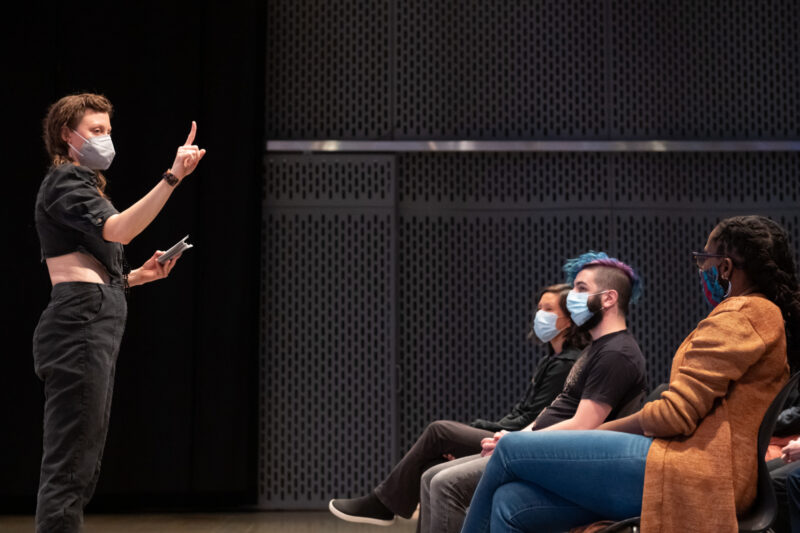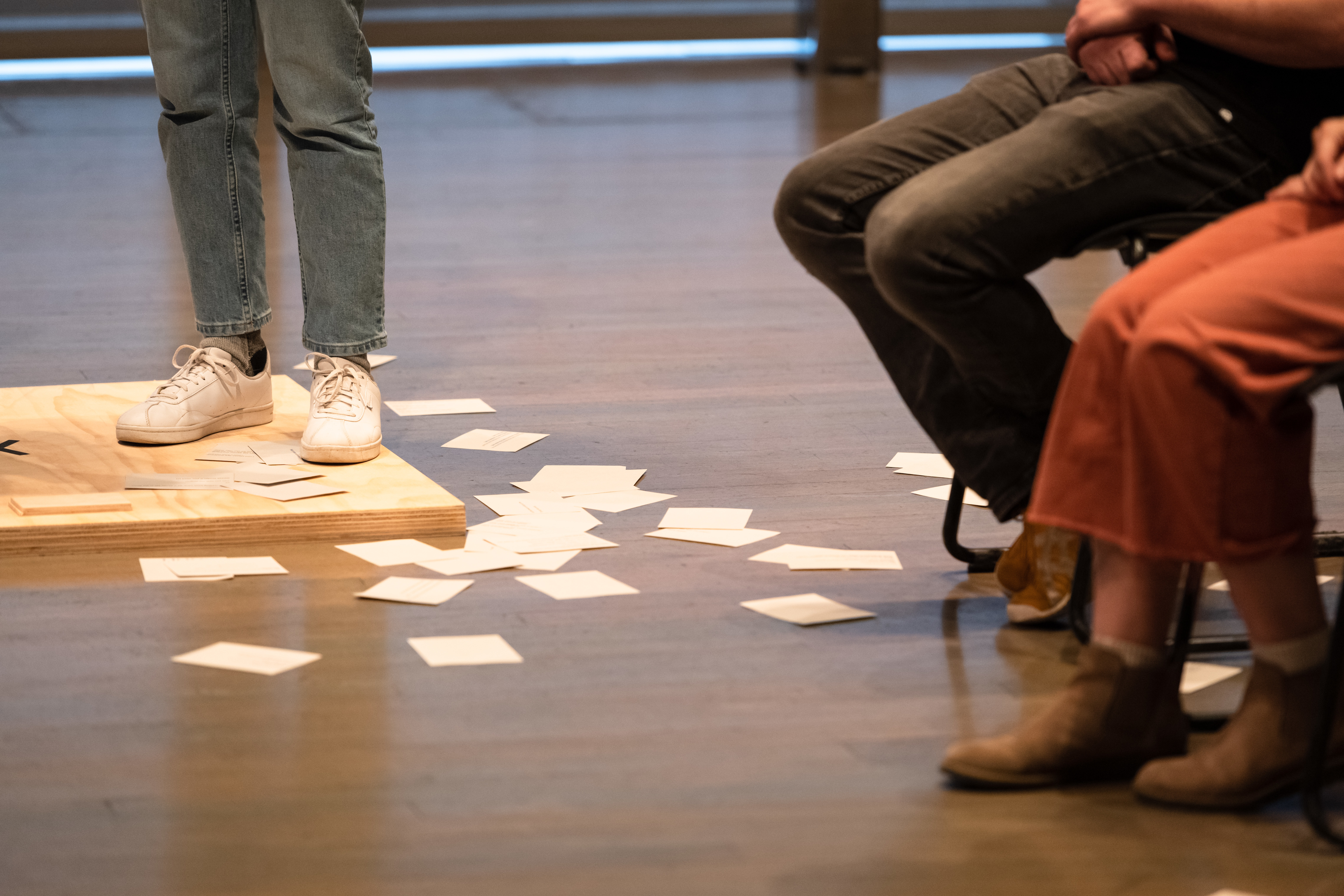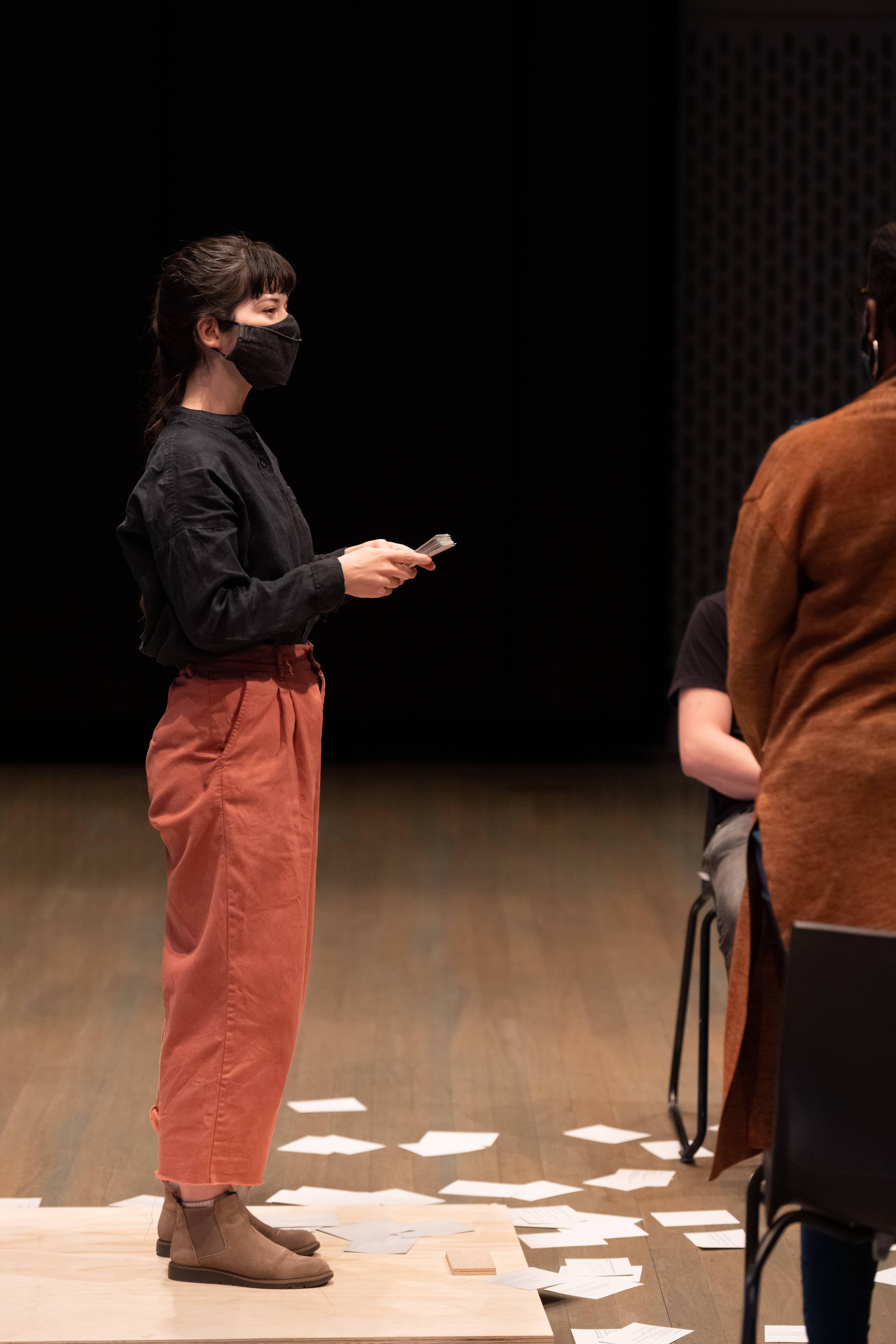You Nervous?
Review of A Thousand Ways (Part Three): An Assembly presented by On The Boards
Written by Teen Writer Kyle Gerstel and edited by Teen Editor Triona Suiter

“The moment you think you understand a great work of art, it's dead for you.” - Oscar Wilde
I enter On The Boards with a friend. After spending a year awaiting the final installment of A Thousand Ways, a series of controlled encounters between strangers, I am thrilled to see what theatremakers Michael Silverstone and Abigail Browde of 600 HIGHWAYMEN have created.
Sixteen chairs face upstage, twelve of which are already taken by adults. We sit and look behind us—the auditorium is empty. My friend bounces their left knee. “You nervous?” I ask. They respond, “A little.”
A Thousand Ways (Part Three): An Assembly concludes 600 Highwaymen’s triptych of theatrical responses to the various stages of the pandemic. In An Assembly, 16 audience members read from a deck of index cards and engage in a wide variety of activities, such as answering personal questions and participating in shared imagination exercises. This structure allows the show to simultaneously maintain a sense of variety and coherence. Although the format is similar to the previous installments, the greater number of participants makes it more of an exploration of communal connection than intimacy.

In my interview with the creators, Browde shared that the development process for An Assembly was difficult because COVID-19 protocols are constantly changing. “All of a sudden, everyone’s dropping mask mandates and if we’re too comfortable coming together, does it still hold the spark of the question which is all about returning?”
However, even though the shows are built to react to the current moment, I believe they are successful because of each show’s fresh approach to the timeless theme of communication. For example, one activity in An Assembly requires putting a hand on another audience member’s shoulder. “That’s scary any time, but especially now,” Browde said.
As our expectations for the pandemic’s ending have shifted, the theatremakers have had to adapt. “We thought it would be way more celebratory, way more loose,” Browde explained. “[However], we can’t ignore the moment. Part three is more about sitting in grief, albeit collectively, but making space for that to be okay.” Silverstone added, “I’m proud of the fact that we have stayed honest about the time and we’ve tried to really examine what we want to be making.”
Silverstone and Browde also believe that mundane prompts are oftentimes more telling than those intended to penetrate. I believe this emphasis is why the triptych is so unique and results in vulnerable, authentic communication. “If you make the questions too provocative or intimate, some people shut down,” Browde said. “Questions that are seemingly surface actually reveal quite a lot.”

One of my favorite moments in An Assembly requires passing around objects from audience members’ pockets. In my cohort, one audience member pulls out a vape pen. It is fascinating to see the variety of reactions as it is passed around—some participants have clearly never touched one while others are presumably seasoned vape pen holders.
Despite my praise, An Assembly lacks the depth and freshness of the first two installments. One of the main reasons A Phone Call was exciting was because there was only virtual theatre at the time, which rarely demands audience engagement. Although the structure had already been established, An Encounter worked nearly as well because we were just beginning to congregate in person again.
The increase in participants for An Assembly isn’t as effective as the previous subversions, but the show still serves as a fitting conclusion to the triptych and an enriching experience on its own. Like its predecessors, An Assembly is both timely and timeless, detached and connected, and well-planned yet seemingly spontaneous. As Browde said, “They’re pieces for considering other people.”
Going into A Phone Call, I was nervous because of the show’s unusual format—I was afraid I wouldn’t be artsy or intellectual enough to appreciate it. In An Assembly, my friend and I were nervous because we were sitting onstage with a group of adults. In both instances, there was a sense that we were out of place.
As an artist and person, I am excited for us to come out of the pandemic, but I’m not sure we should think of it as a return. The simultaneous heightening and numbing of reality over the last two years allowed for widespread recognition of the problems poisoning our society, but these issues were prevalent beforehand. After reflecting upon An Assembly, I believe it is necessary to ask ourselves not only how we can move forward, but how we think we should. Will the world look the same? Probably not. Do we want it to? I’m not sure. All I know is that I’m nervous, and in pursuit of a better world; I hope you are too.
A Thousand Ways (Part Three): An Assembly was presented by On the Boards March 3-12, 2022.
Lead Photo: A Thousand Ways (Part Three): An Assembly at the Institute of Contemporary Art/Boston. Photo by Liza Voll Photography.
The TeenTix Newsroom is a group of teen writers led by the Teen Editorial Staff. For each review, Newsroom writers work individually with a teen editor to polish their writing for publication. The Teen Editorial Staff is made up of 6 teens who curate the review portion of the TeenTix blog. More information about the Teen Editorial Staff can be found HERE.
The TeenTix Press Corps promotes critical thinking, communication, and information literacy through criticism and journalism practice for teens. For more information about the Press Corps program see HERE.


